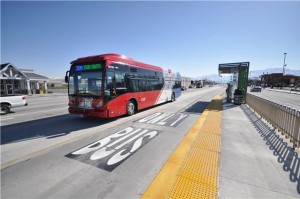
(Photo courtesy Utah Transit Authority)
Christian Nielson is the third generation of his family to live in the Wasatch neighborhood across from BYU’s campus. For years, it has been a single-family neighborhood, but he fears that the legacy of his family may soon come to an end due to controversial transportation routes.
Residents of neighborhoods running along 900 East are uneasy about the possibility of Bus Rapid Transit, or BRT, presence on 900 East.
“We know that BRT encourages commercialization, urbanization and high density housing in close proximity to its routes,” said Wasatch neighborhood resident Nielson. “If BRT is forced up 900 East, it will unarguably alter the legacy of this neighborhood, which is a single-family neighborhood.”
The Provo City website says proposals for the new Bus Rapid Transit system includes everything from increased ridership and stop frequency to designated bus lanes and station upgrades. However, not everybody agrees on the terms of implementing this major undertaking.
Four of the seven Provo Municipal Council members voted in opposition to what came to be called Option 4 last Tuesday, the option that steers BRT around BYU on the east side.
Utah Transit Authority public relations representative Remi Barron explained the consequences associated with opposing Option 4.
“The 900 East route has been most studied and preferred because of its ease of transportation and lower cost,” Barron said. “Without it, project planners will have to go back to the federal government and present a different proposal, so not using Option 4 will slow things down quite a bit.”
For the next couples of weeks, project planners will go back to the drawing board in an attempt to satisfy the best options. Fleeting opportunity for government funding and support inspired the urge to move quickly on the project.
Barron explained that significant federal government funding is only offered to the extent that national BRT guidelines are met. Guidelines include things like high ridership numbers, designated bus lanes and upgraded station amenities.
Provo Municipal Council member Gary Winterton said that despite its opposition, Option 4 is still the best choice when it comes to fulfilling government regulation.
“UTA said they would have to cut routes from other areas of the state with a new BRT system,” Winterton said. “I’m struggling with why other cities would be willing to give up routes if we don’t go up 900 East, because it would cost more to operate due to less government funding.”
Funding is not the only reason Winterton and two other council members voted in support of Option 4.
“I don’t want to handicap BRT from the beginning,” Winterton said.” We’re jeopardizing our chance to have BRT in Provo if we don’t used the least expensive route with the greatest ridership, which is 900 East.”
Winterton also explained that the BRT system will not force residential neighborhoods into any commercialization that they do not welcome.
“BRT is not going to make us develop on 900 East if we don’t want it, but the BRT will be necessary for our whole city.”
As the Municipal Council continues to alter project proposals, Provo residents are uncertain of what is to come.




